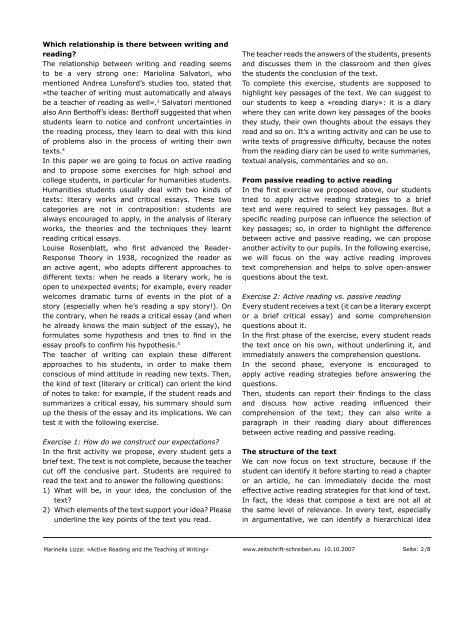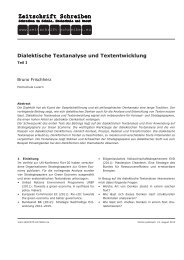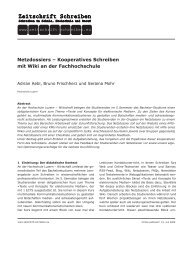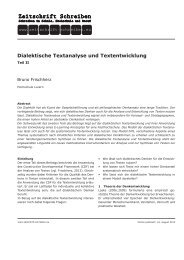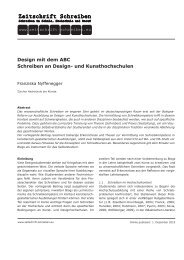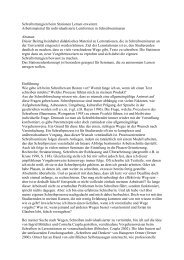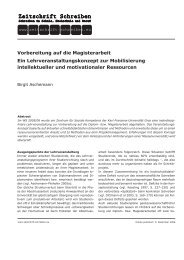Active Reading and the Teaching of Writing - Zeitschrift Schreiben
Active Reading and the Teaching of Writing - Zeitschrift Schreiben
Active Reading and the Teaching of Writing - Zeitschrift Schreiben
Create successful ePaper yourself
Turn your PDF publications into a flip-book with our unique Google optimized e-Paper software.
Which relationship is <strong>the</strong>re between writing <strong>and</strong><br />
reading?<br />
The relationship between writing <strong>and</strong> reading seems<br />
to be a very strong one: Mariolina Salvatori, who<br />
mentioned Andrea Lunsford’s studies too, stated that<br />
«<strong>the</strong> teacher <strong>of</strong> writing must automatically <strong>and</strong> always<br />
be a teacher <strong>of</strong> reading as well». 3 Salvatori mentioned<br />
also Ann Berth<strong>of</strong>f’s ideas: Berth<strong>of</strong>f suggested that when<br />
students learn to notice <strong>and</strong> confront uncertainties in<br />
<strong>the</strong> reading process, <strong>the</strong>y learn to deal with this kind<br />
<strong>of</strong> problems also in <strong>the</strong> process <strong>of</strong> writing <strong>the</strong>ir own<br />
texts. 4<br />
In this paper we are going to focus on active reading<br />
<strong>and</strong> to propose some exercises for high school <strong>and</strong><br />
college students, in particular for humanities students.<br />
Humanities students usually deal with two kinds <strong>of</strong><br />
texts: literary works <strong>and</strong> critical essays. These two<br />
categories are not in contraposition: students are<br />
always encouraged to apply, in <strong>the</strong> analysis <strong>of</strong> literary<br />
works, <strong>the</strong> <strong>the</strong>ories <strong>and</strong> <strong>the</strong> techniques <strong>the</strong>y learnt<br />
reading critical essays.<br />
Louise Rosenblatt, who first advanced <strong>the</strong> Reader-<br />
Response Theory in 1938, recognized <strong>the</strong> reader as<br />
an active agent, who adopts different approaches to<br />
different texts: when he reads a literary work, he is<br />
open to unexpected events; for example, every reader<br />
welcomes dramatic turns <strong>of</strong> events in <strong>the</strong> plot <strong>of</strong> a<br />
story (especially when he’s reading a spy story!). On<br />
<strong>the</strong> contrary, when he reads a critical essay (<strong>and</strong> when<br />
he already knows <strong>the</strong> main subject <strong>of</strong> <strong>the</strong> essay), he<br />
formulates some hypo<strong>the</strong>sis <strong>and</strong> tries to find in <strong>the</strong><br />
essay pro<strong>of</strong>s to confirm his hypo<strong>the</strong>sis. 5<br />
The teacher <strong>of</strong> writing can explain <strong>the</strong>se different<br />
approaches to his students, in order to make <strong>the</strong>m<br />
conscious <strong>of</strong> mind attitude in reading new texts. Then,<br />
<strong>the</strong> kind <strong>of</strong> text (literary or critical) can orient <strong>the</strong> kind<br />
<strong>of</strong> notes to take: for example, if <strong>the</strong> student reads <strong>and</strong><br />
summarizes a critical essay, his summary should sum<br />
up <strong>the</strong> <strong>the</strong>sis <strong>of</strong> <strong>the</strong> essay <strong>and</strong> its implications. We can<br />
test it with <strong>the</strong> following exercise.<br />
Exercise 1: How do we construct our expectations?<br />
In <strong>the</strong> first activity we propose, every student gets a<br />
brief text. The text is not complete, because <strong>the</strong> teacher<br />
cut <strong>of</strong>f <strong>the</strong> conclusive part. Students are required to<br />
read <strong>the</strong> text <strong>and</strong> to answer <strong>the</strong> following questions:<br />
1) What will be, in your idea, <strong>the</strong> conclusion <strong>of</strong> <strong>the</strong><br />
text?<br />
2) Which elements <strong>of</strong> <strong>the</strong> text support your idea? Please<br />
underline <strong>the</strong> key points <strong>of</strong> <strong>the</strong> text you read.<br />
The teacher reads <strong>the</strong> answers <strong>of</strong> <strong>the</strong> students, presents<br />
<strong>and</strong> discusses <strong>the</strong>m in <strong>the</strong> classroom <strong>and</strong> <strong>the</strong>n gives<br />
<strong>the</strong> students <strong>the</strong> conclusion <strong>of</strong> <strong>the</strong> text.<br />
To complete this exercise, students are supposed to<br />
highlight key passages <strong>of</strong> <strong>the</strong> text. We can suggest to<br />
our students to keep a «reading diary»: it is a diary<br />
where <strong>the</strong>y can write down key passages <strong>of</strong> <strong>the</strong> books<br />
<strong>the</strong>y study, <strong>the</strong>ir own thoughts about <strong>the</strong> essays <strong>the</strong>y<br />
read <strong>and</strong> so on. It’s a writing activity <strong>and</strong> can be use to<br />
write texts <strong>of</strong> progressive difficulty, because <strong>the</strong> notes<br />
from <strong>the</strong> reading diary can be used to write summaries,<br />
textual analysis, commentaries <strong>and</strong> so on.<br />
From passive reading to active reading<br />
In <strong>the</strong> first exercise we proposed above, our students<br />
tried to apply active reading strategies to a brief<br />
text <strong>and</strong> were required to select key passages. But a<br />
specific reading purpose can influence <strong>the</strong> selection <strong>of</strong><br />
key passages; so, in order to highlight <strong>the</strong> difference<br />
between active <strong>and</strong> passive reading, we can propose<br />
ano<strong>the</strong>r activity to our pupils. In <strong>the</strong> following exercise,<br />
we will focus on <strong>the</strong> way active reading improves<br />
text comprehension <strong>and</strong> helps to solve open-answer<br />
questions about <strong>the</strong> text.<br />
Exercise 2: <strong>Active</strong> reading vs. passive reading<br />
Every student receives a text (it can be a literary excerpt<br />
or a brief critical essay) <strong>and</strong> some comprehension<br />
questions about it.<br />
In <strong>the</strong> first phase <strong>of</strong> <strong>the</strong> exercise, every student reads<br />
<strong>the</strong> text once on his own, without underlining it, <strong>and</strong><br />
immediately answers <strong>the</strong> comprehension questions.<br />
In <strong>the</strong> second phase, everyone is encouraged to<br />
apply active reading strategies before answering <strong>the</strong><br />
questions.<br />
Then, students can report <strong>the</strong>ir findings to <strong>the</strong> class<br />
<strong>and</strong> discuss how active reading influenced <strong>the</strong>ir<br />
comprehension <strong>of</strong> <strong>the</strong> text; <strong>the</strong>y can also write a<br />
paragraph in <strong>the</strong>ir reading diary about differences<br />
between active reading <strong>and</strong> passive reading.<br />
The structure <strong>of</strong> <strong>the</strong> text<br />
We can now focus on text structure, because if <strong>the</strong><br />
student can identify it before starting to read a chapter<br />
or an article, he can immediately decide <strong>the</strong> most<br />
effective active reading strategies for that kind <strong>of</strong> text.<br />
In fact, <strong>the</strong> ideas that compose a text are not all at<br />
<strong>the</strong> same level <strong>of</strong> relevance. In every text, especially<br />
in argumentative, we can identify a hierarchical idea<br />
Marinella Lizza: «<strong>Active</strong> <strong>Reading</strong> <strong>and</strong> <strong>the</strong> <strong>Teaching</strong> <strong>of</strong> <strong>Writing</strong>» www.zeitschrift-schreiben.eu 10.10.2007 Seite: /8


